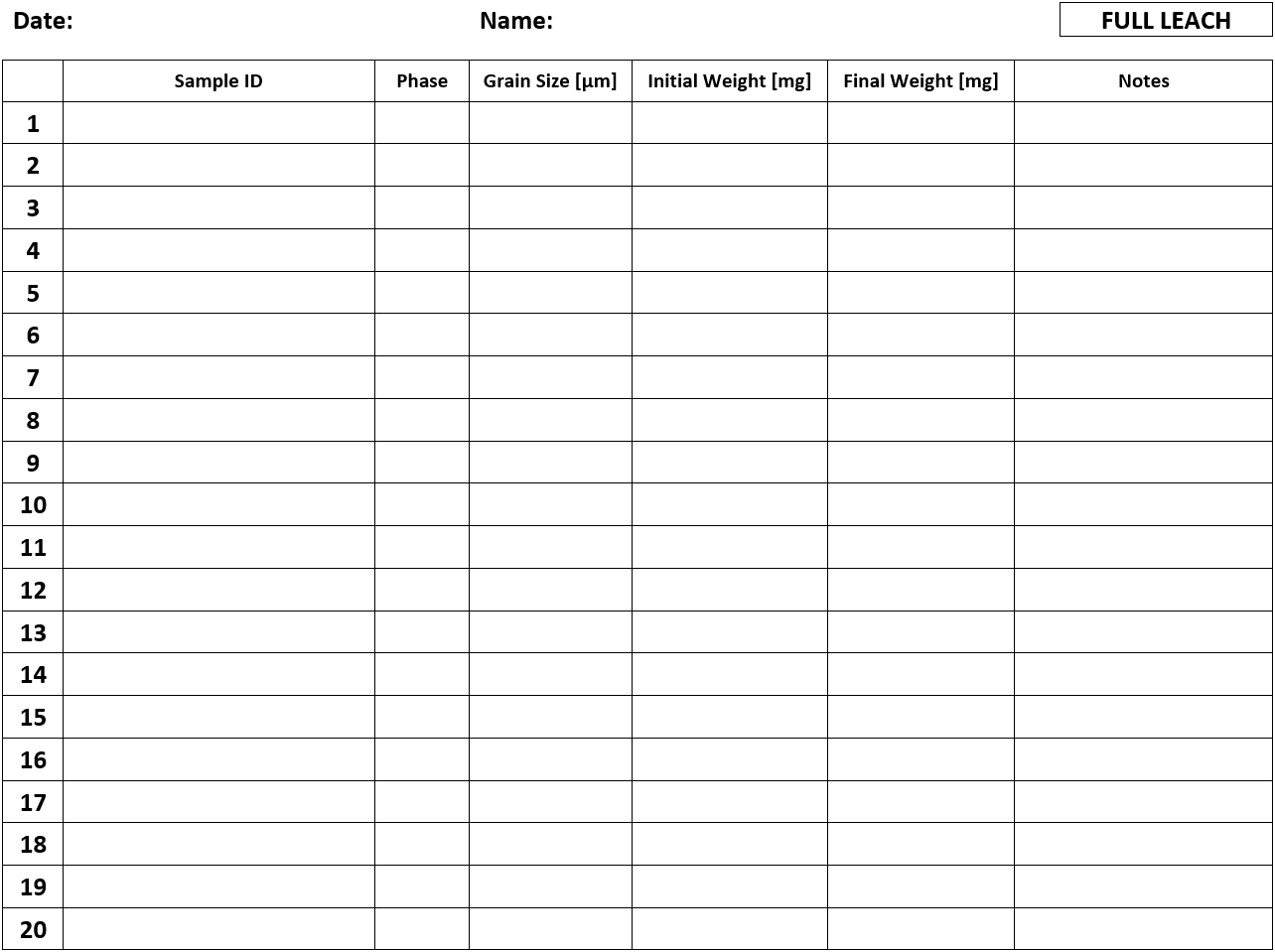Standard Acid Leaching Procedure¶
This acid leaching procedure removes carbonate and clay products that may interfere or contaminate Ar/Ar analyses. The procedure involves placing the sample in a sequence of acids (1N HCl, 6N HCl, 1N HNO3, 3N HNO3) and placing them in a mild ultra-sonic bath.
Geologic Material
groundmass plagioclase
Steps
Workspace Preperation¶
Wipe down all surfaces with water and ethyl alcohol.
Inspect and clean equipment.
Acid Preperation¶
Dilution of acids from concentrate to appropriate normality for acid leaching. In general you will need 500 ml of each of the acids for a standard leach. Below are instructions for making 1 L of the respective acid. Calculations are taken from https://www.sigmaaldrich.com/chemistry/stockroom-reagents/learning-center/technical-library/molarity-calculator.html.
- acid_hcl_6n
From a stock solution of 37% w/w (12.178 M).
To make a 6 M solution, slowly add 492.703 mL of the stock solution to 250 mL deionized water. Adjust the final volume of solution to 1000 mL with deionized water.
- acid_hcl_1n
From a stock solution of 37% w/w (12.178 M).
To make a 1 M solution, slowly add 82.117 mL of your stock solution to 250 mL deionized water. Adjust the final volume of solution to 1000 mL with deionized water.
- acid_hno3_3n
Your stock solution of Nitric Acid is calculated to be 15.698 M based on a density of 1.413 g/mL, a formula weight of 63.01 g/mol, and a concentration of 70% w/w.
To make a 3 M solution, slowly add 191.113 mL of your stock solution to 250 mL deionized water. Adjust the final volume of solution to 1000 mL with deionized water.
- acid_hno3_1n
Your stock solution of Nitric Acid is calculated to be 15.698 M based on a density of 1.413 g/mL, a formula weight of 63.01 g/mol, and a concentration of 70% w/w.
To make a 1 M solution, slowly add 63.704 mL of your stock solution to 250 mL deionized water. Adjust the final volume of solution to 1000 mL with deionized water.
Acid Leach Log Sheet
Acid leaching is conducted in LDPE bottles. The bottles have pre-assigned numbers and the sample name is not put on the bottles, but assigned a number. The sample name is written next to the number of the available bottle.
Steps
Gather samples that will be leached.
Gather the same amount of LDPE bottles that are appropriatly sized for the amount of sample that will be leached.
Assign a number to a sample and write it down on the acid leaching log.
Check that the number and the assigned sample are correct.

Gather supplies and PPE.
- Personal Protection Equipment
Eyes: Tight-fitting goggles
Hands: Viton or nitrile gloves
Body: Lab coat, long pants and closed-toed shoes
- HDPE Bottles
Use large HDPE bottles if you have lots of sample. They sit better in the bath, but beware, you will use more acid.
Use small HDPE bottles for small samples. They tend to tip over in the bath.
- Acid (best to prepare acid ahead of time)
1L of 1N HCl
1L of 6N HCl
1L of 1N HNO3
1L of 3N HNO3
3 - 1,000 mL glass beakers (for acid waste)
2 - 300 mL glass beakers (for pouring acid into and out of bottles)
2 - small plastic trays
Set ultrasound to 50°C.
Line up the samples in the fume hood on one of the plastic work trays.
Setup two of the 1 L beakers on a small tray, next to the tray with the samples. These two beakers will be used for acid waste.
Take a sample and remove the cap and place the top of the cap downwards on to the plastic tray.
- Acid Leach Step 1M HCL.
Carefully pour about the acid equal to about double the volume of grains. Generally no more than half the volume of the bottle. Close the bottle and swirl the bottle for a few moments to mix.
Continue adding acid for the remaining samples.
Set timer on the sonic bath for 60 minutes..
Swirl samples every 15 minutes.
If solution becomes cloudy, replace with fresh acid.
Rinse at least 3 times with Milli-Q water after 60 minutes is up.
Pour off acid into 1,000 mL beakers during rinse.
Repeat last step for each acid as well as an additional time for milli-Q water. Continue to rinse until the sample is no longer cloudy.
Label 300 mL glass beakers with the numbers that were used for acid leaching.
Transfer the samples from the bottles to the glass beakers with their respective numbers. To do this, add a small amount of milli-q water to the bottle. Swirl the water and quickly pour it into the glass beaker. Repeat to get all of the material out of the bottles.
Place samples in an oven to dry overnight. The oven should be at a temperature no higher than 55 C.
Leave it the way you found it.
Put all items away.
Clean all glass beakers with water.
Wipe down work surfaces.
Clean used LDPE bottles and beakers.
